Abstract
A direct current (DC) microgrid containing a photovoltaic (PV) system, energy storage and charging reduces the electric energy conversion link and improves the operational efficiency of the system, which has a broad development prospect. The instability and randomness of PV and charging loads pose a challenge to the safe operation of DC microgrid systems. The safety of grid operation and charging need to be taken into account. However, few studies have integrated the safety of charging devices with grid operation. In this paper, a two-level control strategy is used for the DC microgrid equipped with hybrid energy storage systems (ESSs) with the charging equipment’s safety as the entry point. The primary control strategy combines the health of the charging equipment with droop control to effectively solve the problem of common DC bus voltage deviation and power distribution. The consistency the control algorithm for multiple groups of hybrid ESSs ensures the local side DC bus voltage level and ensures reasonable power distribution among the ESSs. The simulation results in MATLAB/Simulink show that the control strategy can achieve power allocation with stable voltage levels in the case of fluctuating health of the charging equipment, which guarantees the safe operation of the microgrid and charging equipment.
1. Introduction
A typical application of a direct current (DC) microgrid is the inclusion of photovoltaic (PV) power generation systems, energy storage systems (ESSs), electric vehicle (EV) charging systems, etc. It is of great significance to promote energy conservation and emission reduction and achieve sustainable energy development. If the DC microgrid integrating these systems is operated in an uncoordinated way, then it will inevitably affect the power quality and voltage stability [1], and endanger the safe operation of charging devices and cause charging accidents. The safety performance of the charging devices gradually decreases with the increase in the usage time. There has been considerable research on charging device safety by relevant scholars, and a comprehensive review of state assessment methods for charging devices was presented in [2], but rarely was the safe operation of charging devices studied in conjunction with the operation of the power grid.
To ensure the reliable operation and power quality of microgrids and the safe operation of charging devices, it is important to mitigate the power fluctuations caused by these renewable energy sources and provide stable DC bus voltages. The energy management strategies applied in conventional DC microgrids are mainly classified into three categories: centralized control, distributed control and hierarchical control. Distributed control requires only local communication to achieve self-management and control; droop control enables current sharing by adding a virtual resistance control loop with plug-and-play capability [3,4]. Distributed control combined with the characteristics of droop control can achieve load power distribution simply and reliably. Distributed control based on droop characteristics has become the focus of research by scholars at home and abroad, but this control method is difficult to solve the conflict between DC bus voltage deviation and accurate current distribution [5,6]. A nonlinear droop control method was proposed in [7] to find the nonlinear droop coefficients for the DC microgrid system to satisfy the voltage regulation and the current-sharing accuracy. Reference [8] proposed an advanced distributed secondary control scheme based on droop control and fuzzy logic control for an isolated DC microgrid with multi-group distributed generation (DG), which can also solve the above contradictions well. Grasshopper optimized intelligent algorithm was also added to the droop control, which can optimally adjust the PI controller parameters to ensure the power quality of the islanded DC microgrid [9]. Aluko, A. et al. used an artificial peak swarm optimization algorithm to optimize the weighting parameters used to balance the mean current and voltage regulation [10]. Liu, X.K. et al. proposed iterative learning algorithms in a game-theoretic framework to solve the equalization and voltage regulation problems [11]. However, the limitations of all these intelligent algorithms are a high computational cost and more complex methods. It can be seen that there have been more research results on relevant control methods in DC microgrids without energy storage.
ESSs are usually an integral part of DC microgrids to balance the power flow between renewable energy sources and load systems [12,13,14,15]. In islanded DC microgrids with ESSs, droop control is also commonly used to achieve power sharing in ESSs [16,17]. The DC microgrid studied in [18] not only connected PV panels, an external grid and loads, but also considered electric vehicles and distributed ESSs. It mainly addressed the dynamic load distribution of ESSs in the microgrid but did not consider the issue of electric vehicle charging safety. A distributed secondary control scheme was proposed in [19] for voltage restoration and accurate power distribution in an isolated DC microgrid with a single group of ESSs. For centralized ESSs, droop control can achieve ideal power distribution performance [20], which is less applicable for distributed energy storage. In [21], a control method based on multiagent was proposed, which incorporated voltage regulation with a state-of-charge (SOC) balancing control method. It regulated the droop parameters by balancing the SOC, which can achieve good results. In DC microgrids with a PV system and an ESS, the control method based on nonlinear theory overcame the drawbacks of droop control and ensured accurate voltage regulation [22]. Choi, J.-S. et al. directly used the distributed ESS to achieve the regulation of the DC bus voltage, which improved the reliability of the DC microgrid [23]. In [24], a fuzzy logic algorithm was used to adjust the droop factor, and it could achieve SOC balancing and power balancing for a single group of PV energy storage. However, these studies did not consider the power distribution problem of a multi-group system connected in parallel.
Supercapacitors (SCs) are characterized by a fast response time with high instantaneous output power, which can well compensate for the slow dynamic performance of energy storage batteries (ESBs). Rocabert, J. et al. illustrated the advantages displayed by ESS applications configured with SCs in microgrids [25,26,27]. In contrast, it is difficult to achieve coordinated control between multiple systems using conventional droop control [28]. For this reason, Zhang, X. et al. proposed a hybrid algorithm based on model predictive control (MPC) and iterative learning control to cope with sudden load changes in a PV islanded DC microgrid with a single group of hybrid ESSs [29]. Wu, X. et al. proposed an adaptive energy optimization method for hybrid ESSs in order to maintain the stability of the DC bus voltage, but only for single-group PV hybrid ESSs, without involving multi-system coordinated control [30]. Mathew, P. et al. proposed a multi-stage hybrid control scheme for DC microgrids with hybrid ESSs, combining a central controller with distributed control, while briefly considering the interaction between EV charging stations and the grid [31], but the communication topology of this control scheme is more complex.
In summary, there are many existing studies on the voltage stabilization and current distribution strategies of the DC microgrid, but they seldom involve multi-group distributed hybrid ESSs; moreover, they seldom consider and integrate them into the control strategies of the DC microgrid from the perspective of the safe operation of electric vehicle charging equipment. To this end, this paper systematically considers the safety states of PV power generation systems, multi-group hybrid ESSs and charging devices, establishes the structure and model of the studied PV energy storage and charging DC microgrid, and proposes a distributed secondary hierarchical control strategy. In the distributed first-level control strategy based on the droop control characteristics, the safety state of EV charging equipment is incorporated. The microgrid can still respond quickly to the power distribution as well as maintain the stability of the common DC bus voltage when the safety state of charging equipment changes. At the same time, the load power allocation of local charging equipment is also fully considered in order to be closer to reality. The distributed secondary control strategy is based on the consistency algorithm to achieve coordinated control among multiple groups of hybrid energy storage to balance the system power and stabilize the DC voltage to ensure the safe operation of the charging equipment and the grid. To sum up, the main contributions of this work are:
- In this paper, a distributed two-level control strategy applicable to the DC microgrid is investigated, which includes the system-level control strategy of the DC microgrid and the control method of the multi-group distributed hybrid ESSs based on the consistency algorithm.
- Starting from the safety of the charging equipment, the health measure of charging device safety is incorporated into the droop control to maintain the system stability and safe operation. In addition, to eliminate the influence of local charging loads, the local charging loads are equated to the public charging loads. Based on this, the control method is improved.
- Hybrid ESSs can regulate the local DC bus voltage deviation. To fully utilize the technical characteristics of different energy storage, a DC microgrid model containing ESBs and SCs is developed. The effectiveness of the above control strategy under this model is verified by simulation.
2. Structure and Model of a DC Microgrid
2.1. Structure
The structure of the DC microgrid with integrated PV energy storage and charging studied in this paper is given in Figure 1. To smooth out the power fluctuation and improve the reliability and stability of the DC microgrid system, the hybrid ESS is configured in the DC microgrid system studied in this paper. The DC microgrid operates in the islanding case and consists of a PV system, ESSs, DC–DC converters, and DC charging loads. The PV array and ESS are connected by the DC–DC converter to form a PV energy storage unit. To improve the robustness of the system, this paper considers multiple groups of PV energy storage and charging units connected in parallel to a common DC bus, to realize the flow of power between different units and achieve a reasonable power distribution.
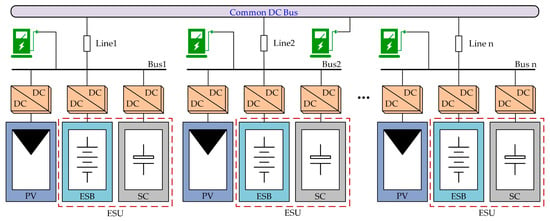
Figure 1.
Structure diagram of the DC microgrid with integrated PV energy storage and charging.
The following is an example of a set of PV energy storage and charging DC microgrids as shown in Figure 2.
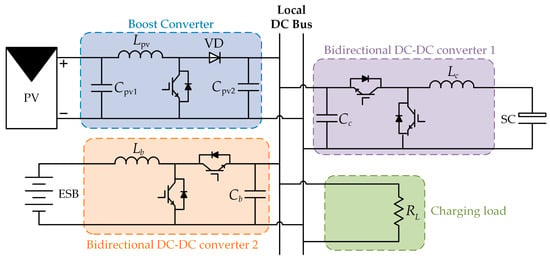
Figure 2.
Single-group PV energy storage and charging system model with a boost converter and DC–DC converters.
The PV power generation system is connected to the DC bus via a boost-type unidirectional DC–DC converter. To capture as much solar energy as possible, it works in maximum power point tracking (MPPT) mode so that it operates at the highest efficiency. When solar energy is abundant and PV output is high, the DC bus voltage increases, which will directly affect the charging safety of electric vehicles. So, the PV system needs to coordinate the ESS to regulate the system power to maintain the voltage stability.
The energy storage unit includes ESBs and SCs, which are connected to the DC bus in parallel via a bidirectional DC–DC converter. Due to the uncertainty and fluctuation of the charging load, to ensure the normal and safe operation of the charging equipment, a suitable control strategy is used for the ESU to maintain the power balance and stabilize the DC bus voltage. The ESB in the hybrid ESS has a high energy density and the SC has a fast dynamic performance, which can respond to power fluctuations with different characteristics.
The DC charging load can be considered a constant power load and is divided into local charging load as well as public charging load, which are hooked up to the DC bus and public DC bus, respectively. With the increasing power of charging equipment, the safety of charging equipment must be given attention. In reference [32], the authors combined the fuzzy comprehensive evaluation method with a neural network algorithm to construct a comprehensive vehicle–pile–net safety state evaluation system and divided the charging equipment into five safety levels. In this paper, operational wear parameters and operational parameters are taken into account in the evaluation of charging devices. The operational wear parameters include the degree of wear and tear of the equipment, the total number of charging hours and the number of years of use. The operating parameters include equipment insulation monitoring parameters, power monitoring parameters and temperature monitoring parameters of key components of the charging equipment. Obviously, there is a relationship between each parameter and the operating power of the charging equipment. The charging equipment health degree factor m, which is divided into five grades, is introduced as the weight of the operating power of the charging equipment. The correspondence between the health degree and the safety level is obtained by using the integrated fuzzy evaluation method and the fuzzy statistical method. The specific algorithm is shown in the following Figure 3 and the results are shown in Table 1 below.
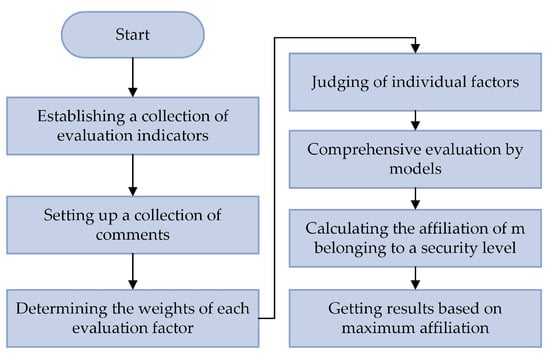
Figure 3.
Flow chart of fuzzy comprehensive evaluation method of charging equipment safety.

Table 1.
Correspondence between charging equipment health degree and safety grade.
2.2. Boost Converter Model
To simplify the analysis, only the two ideal states of the boost converter with the switching tubes off or on are considered, as shown in Figure 4.

Figure 4.
Equivalent circuit schematic of boost circuit in two working modes. (a) Equivalent circuit when the switch is off in the boost circuit; (b) Equivalent circuit when the switch is on in the boost circuit.
According to the diagram, the differential equations of the circuit in the two states are listed as shown in Equations (1) and (2).
The state of the switching tube is represented by the switching function d, which is the duty cycle of the converter. Therefore, using the state space representation and combining Equations (1) and (2), the boost circuit is represented as follows in the state space model [26]:
where is the input voltage of the boost converter, is the output voltage of the converter, and is the state vector. A, B, C and D are the system parameter matrices, expressed as follows:
2.3. Energy Storage Converter Model
The energy storage converter is a bidirectional DC–DC converter operating in two modes. When operating in boost mode, the ESU is discharged and the mathematical model of the converter is basically the same as that of the above boost converter, so this section will not go into details. When the energy storage converter operates in buck mode, the ESU is in the charging state, as shown in Figure 5.

Figure 5.
Equivalent circuit schematic of buck circuit in two working modes. (a) Equivalent circuit when the switch is off in the buck circuit; (b) Equivalent circuit when the switch is on in the buck circuit.
According to Figure 5, the differential equations in the steady state are shown in Equations (5) and (6) below:
Introducing the duty cycle q of the buck circuit, the state space equation combining Equations (5) and (6) is shown below:
3. Control Strategy
3.1. MPC-Based MPPT
The PV system has an irreplaceable role in the DC microgrid system studied in this paper, and the unstable output characteristics of the PV array when the external environment changes abruptly pose a serious challenge to the stability and robustness of the system. In this paper, a PV maximum power point tracking algorithm based on MPC is used to balance the control accuracy and tracking speed of the PV system under the change of external factors.
According to Equation (3), the discrete state space equation of the boost circuit is obtained by applying the forward Euler method, as shown in Equation (8):
where is the sampling period and k is the sampling moment. S is the switching state, which is defined as:
Based on Equation (7), the MPPT algorithm is optimized by using the parameter values of the current moment. By solving the model, it is possible to predict the voltage and current values of the next moment, thus predicting the future actions of the control variables. In addition, the minimum value of the error between the reference and predicted values is used as a constraint and is expressed as a function of FS:
where is the predicted output voltage; is the predicted PV current; , is the reference value.
According to Equation (10), the algorithm requires both voltage and current sensors. In this paper, the PV output current can be calculated by combining the output characteristics of the PV as shown in Equation (11), so that the current sensor can be eliminated [33,34].
Where iph is the photogenerated current of the cell panel, io is the reverse saturation current of the equivalent diode, RS is the series resistance of the module, Rsh is the equivalent bypass shunt resistance, the rest of the quantities in the formula are coefficients with fixed values or are constants.
The MPPT algorithm using MPC is shown in Figure 6 below. In this case, the perturb and observe (P&O) algorithm generates the reference voltage, which is based on the principle of setting a perturbation on the original output voltage and determining the maximum power point by comparing the output power before and after the perturbation. The output value of the P&O is fed into the MPC controller as a reference quantity. Then the voltage at the next moment can be predicted and compared to select the optimal switching state. This method can save the PI controller as well as the PWM generator.
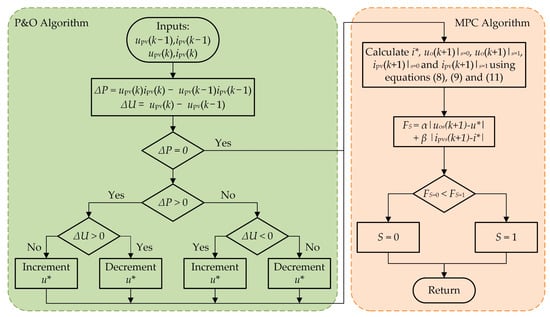
Figure 6.
MPC-based MPPT algorithm for PV boost converter.
3.2. A Distributed Two-Level Control Strategy for the DC Microgrid
3.2.1. Primary Control Strategy for the DC Microgrid
In DC microgrids, simple and reliable droop control is applied as a primary control strategy to ensure stable system operation [35]. Droop control is the control of a DC converter based on the relationship between voltage and power or voltage and current, using the DC bus voltage as the input signal. In the PV energy storage and charging DC microgrid, good voltage quality and reasonable distribution, and a fast response of the charging equipment power among system units are the prerequisites for the safe operation of the charging equipment. For the steady-state operation of the DC microgrid, a set of a PV power generation unit and a hybrid ESU are equated as an ideal voltage source in series with a resistor, as shown in Figure 6. The output characteristics using droop control can be expressed as:
where un is the output voltage of the nth group of the PV energy storage system; is the rated output voltage of the PV energy storage system, i.e., the open-circuit voltage of the PV energy storage system; in is the output current of the PV energy storage system; Rn is the virtual resistance of the system. In Figure 7, Rln is the line impedance of the nth line.
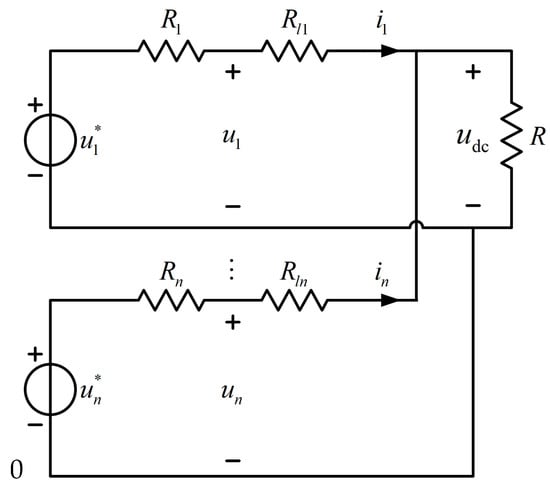
Figure 7.
DC microgrid equivalent model with multiple DGs.
In general, the voltage reference value of each group of the PV energy storage system should be set to the same, according to Figure 7, then the outlet current of each unit can be obtained as:
The outlet current relationship between any two groups of PV energy storage systems is:
The outlet power of a single group of PV energy storage systems is expressed as:
According to Equation (14) above, the system output current is proportional to the sum of the virtual impedance and the line impedance. As shown in Figure 8 below, the mismatch of the line parameters results in the designed conventional droop controller not being able to find a deviation-free solution to the inherent contradiction between accurate power distribution and voltage.
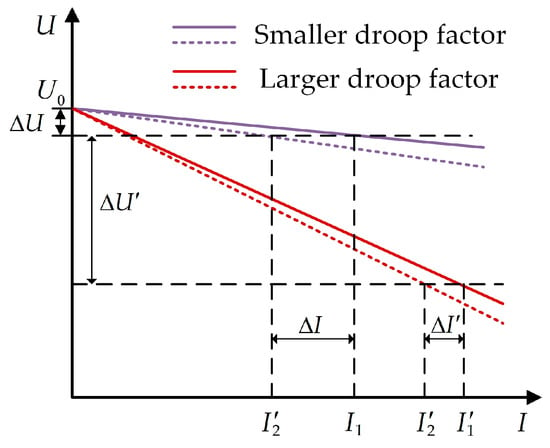
Figure 8.
Illustrative diagram of the limitations of traditional droop control containing the differences between the two groups of DG systems.
To solve the power distribution problem, this paper introduces the adaptive virtual resistance gn to correct the droop control curve so that is 0, then Equation (12) is modified as:
At this time, the power emitted by the PV energy storage unit is:
In order to realize the power distribution of the DC microgrid system among the individual PV energy storage units, it should therefore satisfy:
Additionally, because
Then the control equation with the common DC bus voltage as the reference quantity can be obtained as:
where is the control reference value of the bus voltage of each PV energy storage unit.
The charging equipment is considered a constant power load in the DC microgrid, both as a local load and a public load. In order to simplify the model, the local charging equipment load is equated to the public load and the power is distributed uniformly according to the public load, and the schematic and equivalent diagrams are shown in Figure 9.

Figure 9.
Equivalent schematic of microgrid for equating local charging load to public load.
According to Figure 8, it is easy to obtain:
Solving the above equation yields:
Considering the safety of the charging equipment, the charging equipment conducts the safety assessment based on the operating status of the equipment, which is used to adjust the power and share the information with the grid. Based on the safety operation information of the charging equipment, the PV energy storage system coordinates the power output of the control system:
is the rated reference output of the nth group of PV energy storage units; is the rated power of the charging equipment.
To facilitate the characteristic relationship between voltage and power, Equation (19) is transformed into:
where is the droop factor.
For the improved droop control strategy shown in the above Equation (24), only the DC bus voltage needs to be shared, which can realize the power distribution of the charging equipment in a safe operating condition and improve the operating efficiency of the DC microgrid system. However, there is still a common DC bus voltage offset, which is:
In this paper, the voltage compensation strategy is adopted to compensate the drop of the bus voltage within a limited time T, that is:
In the equivalent circuit shown in Figure 6, it is obtained by Kirchhoff’s laws:
Simplified to obtain the common DC bus voltage as:
It can be seen from Equation (24) that the DC voltage of each PV energy storage unit can track its control reference value. Combining with Equation (28), it is easy to find that the DC bus voltage is related to the control reference value of the voltage, line resistance, droop factor and equivalent load resistance. For a fixed DC microgrid system, the line resistance is usually constant. Therefore, the method of rectifying the voltage reference value can be chosen.
The derivation from Equation (28) is:
Since the above Equation (29) is a constant, the amount of compensation for the bus voltage can be expressed as:
where K is the compensation factor. Accordingly, Equation (30) can be modified as:
In this section, by considering the charging safety and health factors of charging devices, an improved droop control strategy for the DC microgrid applicable to charging devices is proposed, as shown in Figure 10. The control strategy consists of two parts: the droop control considering charging safety and the voltage compensation control, and it takes into account the impact of the local charging load on the microgrid. To implement the method, it generates reference voltage signals and provides them to the secondary control. This control strategy is locally distributed control, which requires the health information of the charging equipment and the DC bus voltage information. The microgrid system reasonably distributes the power according to the health information of the charging equipment and ensures the voltage quality of the DC bus.
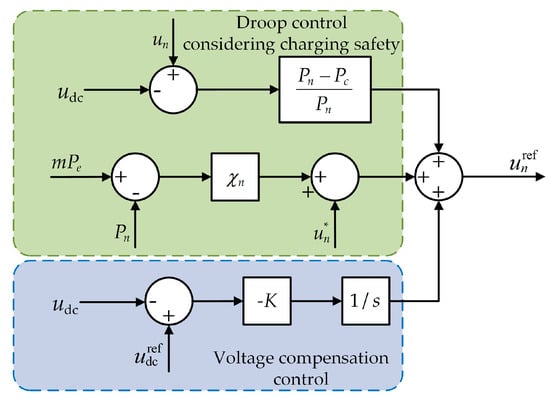
Figure 10.
Primary control strategy for the DC microgrid based on improved droop control.
3.2.2. Secondary Control Strategy of the DC Microgrid
To make a reasonable distribution of power among ESUs, this paper investigates the hybrid energy storage coordination control strategy based on consistency theory as a secondary control strategy for islanded DC microgrids.
Considering each ESU as a node, the access point voltage of each node is not the same, and the node voltage needs to be exchanged with its neighboring nodes for information [36]. The communication architecture is shown in Figure 11 and expressed by the adjacency matrix as:
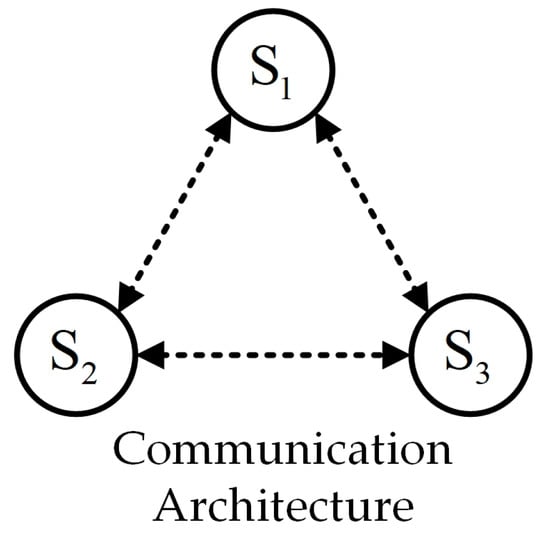
Figure 11.
Bidirectional ring network communication structure for the DC microgrid with ESSs.
To obtain the average value of the bus voltage, the output value of the next moment is updated using the local measurement node voltage and the shared voltage information for calculation as:
where and are the global average bus voltages at the access points of group i and j hybrid ESUs.
The SC has high power density and a fast response, and its controller aims to suppress the fluctuation of the DC bus voltage. On this basis, it is required that each SC is uniformly discharged to keep the terminal voltage of the SC consistent. The control strategy of the SC based on the proportional–integral (PI) controller is shown in Figure 12 below. The difference between the average bus voltage and the control voltage reference is used as the input, and the bus voltage can be corrected by the control of the current inner loop. On the other hand, the difference in the SC terminal voltage is the input to the controller to correct the SC terminal voltage.
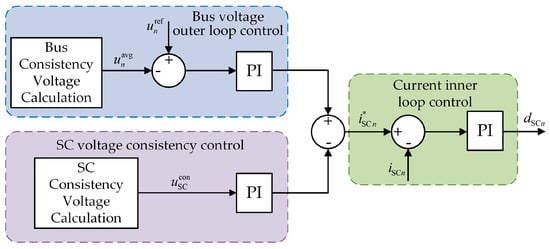
Figure 12.
Control scheme of the SC controller for bidirectional DC–DC converter 1.
Based on the consistency algorithm, the ESB controller is used to balance the charge state of the ESB. However, when the bus voltage fluctuates, the SC responds quickly to stabilize the bus voltage, and a voltage control loop needs to be incorporated to maintain the end voltage level of the SC. The resulting control strategy to improve the voltage outer loop and current inner loop is shown in Figure 13. The SC voltage control is simultaneously added to the controller outer loop with the SOC consistency control. Its output value corrects the reference current of the ESB, and finally the control target can be achieved.
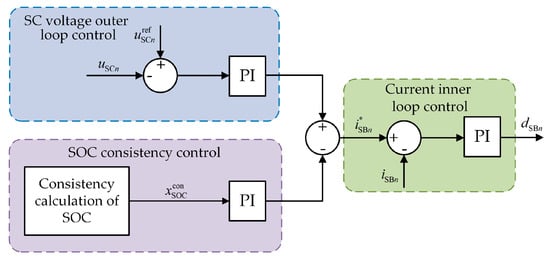
Figure 13.
Control scheme of the ESB controller for bidirectional DC–DC converter 2.
The overall control strategy of the islanded DC microgrid studied in this paper is shown in Figure 14 below. It can be seen that the two-level control strategy consists of the improved droop control strategy and the consistent energy storage control strategy, and the influence of charging equipment health is considered in the primary level of control. In the primary control, the droop control is used as a basis for improvement, which can provide voltage reference values for the secondary control. In the secondary control, the consistency algorithm is added to the control method of the voltage outer loop to provide reference signals for the energy storage converters. The control strategy is local decentralized control, which can improve the DC voltage quality, adapt to the changes in charging equipment health, and ensure the safe and reliable operation of the charging equipment from the network side.

Figure 14.
Overall control strategy for the DC microgrid considering the safety of the charging equipment.
3.3. Small-Signal Models
The differential equation for the shunt voltage regulator capacitor on the common DC bus is:
In general, the measured power needs to be filtered by a first-order low-pass filter to filter out the high-frequency signal of the instantaneous power. Combining Equation (31), it can be obtained:
where
Combining the DC–DC converter, primary controller and secondary controller to build a global small-signal model:
where
is the system characteristic matrix. For a microgrid with a known topology and state, the small-signal stability of the system can be judged based on the eigenvalues of matrix , which provides a basis for the design of the system parameters.
4. Simulation Results
To verify the effectiveness of the proposed control strategy, a simulation model is built in MATLAB/Simulink based on the topological model shown in Figure 1 and Figure 2. The system parameters of the simulation model are shown in Table 2 below. In the control strategy above, the local charging load is equated to the public charging load in consideration. In order to fully verify the effectiveness of its control strategy, the systems with only public load and with both local load and public load are set in the two calculations, respectively.

Table 2.
Simulation model parameters table.
4.1. Simulation Example 1
In this simulation example, the output power of PV1, PV2 and PV3 are set to 10 kW, 10 kW and 20 kW. A charging device with a rated power of 20 kW at the common DC bus is charging and the health of the charging device drops to 0.5 at 5 s. No local charging devices are operating in each distributed generation (DG). Figure 14 shows the simulation results of the DC microgrid.
In Figure 15, the DGs should reasonably allocate the load power according to the capacity ratio, so the output power of DG1 and DG2 should be the same and should be 0.5 of DG3. From Figure 15a, it can be seen that before 5 s, DG1, DG2 and DG3 provide 5 kW, 5 kW, and 10 kW load power, respectively. After 5 s, in order to ensure the charging safety of the charging equipment, the charging equipment is operated at reduced power, so DG1, DG2 and DG3 provide 2.5 kW, 2.5 kW and 5 kW load power, respectively. However, as can be seen in Figure 15b, the relative deviation of power distribution reaches more than 30% under the conventional droop control without considering the safety of the charging equipment. Figure 15c shows that the ESS dissipates the excess PV power, the SC can quickly respond to the load change, and the storage battery responds reasonably to the power distribution at the steady state after a certain time. In Figure 15d,e, it can be seen that after the consistency algorithm, the SOC gap between different ESBs becomes smaller. Due to the outer loop control of the SC voltage in the ESB controller, the SOC of the SC remains consistent during the load change. From Figure 15f, it can be seen that the common DC bus voltage is maintained at the rated value of 500 V, which ensures the power supply quality of the charging equipment. On the contrary, the common DC bus voltage with traditional droop control cannot be maintained at the rated value, which reduces the power supply quality and affects the charging safety performance of the charging equipment.
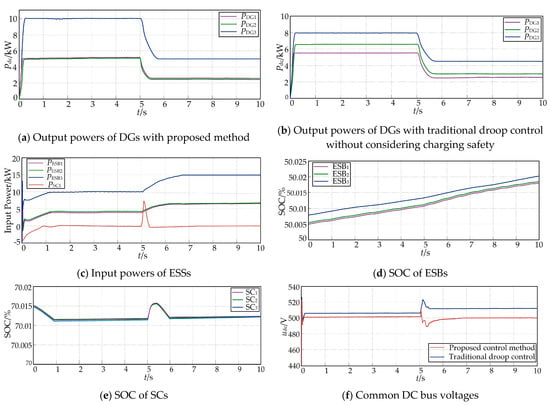
Figure 15.
Simulation results in Example 1.
To better validate the method in this paper, the advanced method proposed in [8] is used for comparison, and the simulation results are shown in Figure 16. The output powers shown in Figure 16a show that the powers can also be well distributed with this advanced method. By comparing Figure 15a and Figure 16a, it can be seen that the time to reach the steady state is longer due to the more complex nature of this advanced method. From Figure 16b, it is observed that the voltage of the common DC bus can also be maintained at 500 V. However, a comparison of Figure 15f and Figure 16b shows that when the charging load changes suddenly, the bus voltage takes a longer period of time to return to its rated value. The voltages of the local DC buses are higher than the voltage of the common DC bus due to the presence of line impedance. The voltages of the local DC buses also remain stable before and after the sudden load change. Therefore, the method in this paper also has good results and even better performance.

Figure 16.
Simulation results of example 1 under the proposed control strategy in [8].
4.2. Simulation Example 2
In this simulation example, both the public charging load attached to the common DC bus and the local charging load contained in each DG of the DC microgrid system are considered. In the simulation parameter setting, the common charging device is running at a rated power of 10 kW. In 0–5 s, the output power of PV1, PV2, and PV3 is 10 kW, 10 kW, and 20 kW, and local charging equipment 1, local charging equipment 2, local charging equipment 3 are running at a rated power of 5 kW, 5 kW, 20 kW, respectively. At 5 s, the sudden condition output power of PV3 drops to 10 kW, and the health of local charging equipment 1, local charging equipment 2 and local charging equipment 3 drops to 0.2, 0.8 and 0.5. Figure 17 show the simulation results of simulation example 2.
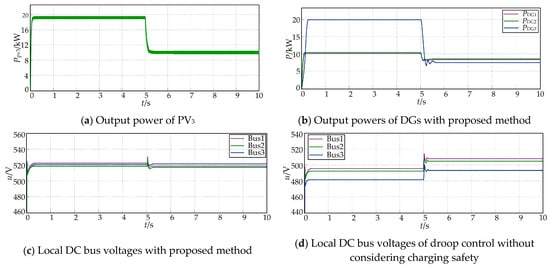

Figure 17.
Simulation results in example 2.
Figure 17a shows that the output power of PV3 suddenly drops at 5 s to reach the steady state quickly, which shows good dynamic performance. Figure 17b shows that the local charging load and the public charging load jointly participate in the load distribution, and each DG can still distribute the power proportionally to the capacity when the health of the charging equipment decreases. However, in Figure 17c, the local DC bus voltage is unstable and the safe operation of the charging equipment is not guaranteed due to the line impedance and the presence of the local charging equipment. In Figure 17d,e, the outlet voltage of each DG system and the SOC of the ESBs are balanced due to the consistency control. Meanwhile, it is known from Figure 17f that the common DC bus voltage is stabilized at 500 V, which guarantees the power quality of the charging equipment. In contrast, the use of traditional droop control without considering charging safety results in the common DC bus voltage deviating from the rated value.
The simulation results under the control strategy proposed in [8] are given in Figure 18. The relative deviations of the power distribution from DG1 to DG3 after 5 s are about 15%, 45%, and 17%. Comparing with Figure 17b, the results in Figure 18a show a large deviation in power distribution because the effect of local load is not considered. In Figure 18b, the common DC bus voltage can still maintain the rated value because of the inclusion of voltage compensation. It is better compared to the common DC bus voltage obtained by the traditional method in Figure 17f. Comparing Figure 17c,d, it is obvious that the local DC bus voltages vary more. This is because the local DC bus voltages are affected in order to meet the load demand. Therefore, the method in this paper is more applicable to the microgrid system where local charging loads exist.

Figure 18.
Simulation results of example 2 under the proposed control strategy in [8].
5. Conclusions
In this paper, a two-level control strategy is proposed for the safe operation of the DC microgrid incorporating a PV system, energy storage and charging. Based on the droop control, a power allocation algorithm for charging loads considering the health of the charging equipment is incorporated, along with a common DC bus voltage compensation strategy. This ensures the load power balance and the voltage level of the common DC bus. Furthermore, the unbalanced power of the system is compensated by the energy storage coordination method based on the consistency control algorithm to eliminate the deviation of the local DC bus voltage, and the SOC of the ESSs converges. The control strategy is based on the information interaction between the microgrid and the charging equipment, which ensures the operational safety of the charging equipment from the grid side. Finally, the simulation results verify the effectiveness of this control strategy.
However, the research in this paper also has the following limitations. Firstly, the communication problem between the systems is not considered in detail, and the communication delay and the communication failure problem may have some impact on the microgrid operation. Secondly, the DC microgrid control strategy studied in this paper is based on microgrid operation in islanding mode, and the control method during grid-connected operation is not studied. In-depth research will be conducted on the above two aspects in the future.
Author Contributions
Conceptualization, X.L.; Formal analysis, X.L.; Methodology, X.L., Z.J. and F.Y.; Visualization, X.L. and Z.J.; Writing—original draft, X.L. and Z.J.; Funding acquisition, Z.J.; Data curation, F.Y.; Resources, F.Y. and Z.D.; Investigation, Z.D. and C.Z.; Validation, C.Z.; Supervision, C.Z.; Writing—review & editing, L.C. All authors have read and agreed to the published version of the manuscript.
Funding
This work was financially supported by the Science and Technology Project of State Grid Corporation of China (Grant No. 52094021N00S).
Institutional Review Board Statement
Not applicable.
Informed Consent Statement
Not applicable.
Data Availability Statement
Not applicable.
Conflicts of Interest
The authors declare no conflict of interest.
References
- Cucuzzella, M.; Kosaraju, K.C.; Scherpen, J.M.A. Voltage Control of DC Microgrids: Robustness for Unknown ZIP-Loads. IEEE Control Syst. Lett. 2022, 7, 139–144. [Google Scholar] [CrossRef]
- Chen, X.; Jiang, T.; Bi, M.; Wang, Y.; Gao, H. A review of condition assessment of charging infrastructure for electrical vehicles. In Proceedings of the IET International Conference on Intelligent and Connected Vehicles (ICV 2016), Chongqing, China, 22–23 September 2016; pp. 1–4. [Google Scholar] [CrossRef]
- Zisen, L.; Shangzhi, P.; Minglong, W.; Wenqiang, L.; Jinwu, G.; Liangzhong, Y.; Praveen, J. A Three-Port LCC Resonant Converter for the 380-V/48-V Hybrid DC System. IEEE Trans. Power Electron. 2022, 37, 10864–10876. [Google Scholar]
- Yang, R.; Jin, J.; Chen, X.; Zhang, T.; Ming, S.; Zhang, S.; Xing, Y. A Battery-Energy-Storage-Based DC Dynamic Voltage Restorer for DC Renewable Power Protection. IEEE Trans. Sustain. Energy 2022, 13, 1707–1721. [Google Scholar] [CrossRef]
- Prabhakaran, P.; Goyal, Y.; Agarwal, V. A Novel Communication-Based Average Voltage Regulation Scheme for a Droop Controlled DC Microgrid. IEEE Trans. Smart Grid 2019, 10, 1250–1258. [Google Scholar] [CrossRef]
- Nahata, P.; La Bella, A.; Scattolini, R.; Ferrari-Trecate, G. Hierarchical control in islanded DC microgrids with flexible structures. IEEE Trans. Control Syst. Technol. 2020, 29, 2379–2392. [Google Scholar] [CrossRef]
- Zhang, Y.; Qu, X.; Tang, M.; Yao, R.; Chen, W. Design of Nonlinear Droop Control in DC Microgrid for Desired Voltage Regulation and Current Sharing Accuracy. IEEE J. Emerg. Sel. Top. Circuits Syst. 2021, 11, 168–175. [Google Scholar] [CrossRef]
- Aluko, A.; Buraimoh, E.; Oni, O.E.; Davidson, I.E. Advanced Distributed Cooperative Secondary Control of Islanded DC Microgrids. Energies 2022, 15, 3988. [Google Scholar] [CrossRef]
- Jumani, T.A.; Mustafa, M.W.; Md Rasid, M.; Mirjat, N.H.; Leghari, Z.H.; Saeed, M.S. Optimal Voltage and Frequency Control of an Islanded Microgrid Using Grasshopper Optimization Algorithm. Energies 2018, 11, 3191. [Google Scholar] [CrossRef]
- Aluko, A.; Swanson, A.; Jarvis, L.; Dorrell, D. Modeling and Stability Analysis of Distributed Secondary Control Scheme for Stand-Alone DC Microgrid Applications. Energies 2022, 15, 5411. [Google Scholar] [CrossRef]
- Liu, X.K.; Jiang, H.; Wang, Y.W.; He, H. A distributed iterative learning framework for DC microgrids: Current sharing and voltage regulation. IEEE Trans. Emerg. Top. Comput. Intell. 2020, 4, 119–129. [Google Scholar] [CrossRef]
- Shen, X.; Shahidehpour, M.; Han, Y.; Zhu, S.; Zheng, J. Expansion planning of active distribution networks with centralized and distributed energy storage systems. IEEE Trans. Sustain. Energy 2017, 8, 126–134. [Google Scholar] [CrossRef]
- Byrne, R.H.; Nguyen, T.A.; Copp, D.A.; Chalamala, B.R.; Gyuk, I. Energy Management and Optimization Methods for Grid Energy Storage Systems. IEEE Access 2018, 6, 13231–13260. [Google Scholar] [CrossRef]
- Zhi, N.; Ding, K.; Du, L.; Zhang, H. An SOC-Based Virtual DC Machine Control for Distributed Storage Systems in DC Microgrids. IEEE Trans. Energy Convers. 2020, 35, 1411–1420. [Google Scholar] [CrossRef]
- Liang, Y.; Zhang, H.; Du, M.; Sun, K. Parallel coordination control of multi-port DC-DC converter for stand-alone photovoltaic-energy storage systems. CPSS Trans. Power Electron. Appl. 2020, 5, 235–241. [Google Scholar] [CrossRef]
- Li, X.; Guo, L.; Zhang, S.; Wang, C.; Li, Y.W.; Chen, A.; Feng, Y. Observer-based DC voltage droop and current feed-forward control of a DC microgrid. IEEE Trans. Smart Grid 2018, 9, 5207–5216. [Google Scholar] [CrossRef]
- Majumder, R.; Chaudhuri, B.; Ghosh, A.; Majumder, R.; Ledwich, G.; Zare, F. Improvement of stability and load sharing in an autonomous microgrid using supplementary droop control loop. IEEE Trans. Power Syst. 2010, 25, 796–808. [Google Scholar] [CrossRef]
- Xiaonan, L.; Kai, S.; Lipei, H. Dynamic Load Power Sharing Method with Elimination of Bus Voltage Deviation for Energy Storage Systems in DC Micro-grids. Proc. CSEE 2013, 3, 37–46. [Google Scholar]
- Guo, F.; Xu, Q.; Wen, C.; Wang, L.; Wang, P. Distributed Secondary Control for Power Allocation and Voltage Restoration in Islanded DC Microgrids. IEEE Trans. Sustain. Energy 2018, 9, 1857–1869. [Google Scholar] [CrossRef]
- Hoang, K.D.; Lee, H. Accurate power sharing with balanced battery state of charge in distributed DC microgrid. IEEE Trans. Ind. Electron. 2019, 66, 1883–1893. [Google Scholar] [CrossRef]
- Wu, T.; Xia, Y.; Wang, L.; Wei, W. Multiagent Based Distributed Control with Time-Oriented SoC Balancing Method for DC Microgrid. Energies 2020, 13, 2793. [Google Scholar] [CrossRef]
- Sun, J.; Lin, W.; Hong, M.; Loparo, K.A. Voltage Regulation of DC-microgrid with PV and Battery. IEEE Trans. Smart Grid 2020, 11, 4662–4675. [Google Scholar] [CrossRef]
- Choi, J.-S.; Oh, S.-Y.; Cha, D.-S.; Ko, B.-S.; Kim, M. Autonomous DC-Bus Voltage Regulation in DC Microgrid Using Distributed Energy Storage Systems. Energies 2022, 15, 4559. [Google Scholar] [CrossRef]
- Tian, G.; Zheng, Y.; Liu, G.; Zhang, J. SOC Balancing and Coordinated Control Based on Adaptive Droop Coefficient Algorithm for Energy Storage Units in DC Microgrid. Energies 2022, 15, 2943. [Google Scholar] [CrossRef]
- Rocabert, J.; Capó-Misut, R.; Muñoz-Aguilar, R.S.; Candela, J.I.; Rodriguez, P. Control of Energy Storage System Integrating Electrochemical Batteries and Supercapacitors for Grid-Connected Applications. IEEE Trans. Ind. Appl. 2019, 55, 1853–1862. [Google Scholar] [CrossRef]
- Liu, Y.; Yang, Z.; Wu, X.; Sha, D.; Lin, F.; Fang, X. An Adaptive Energy Management Strategy of Stationary Hybrid Energy Storage System. IEEE Trans. Transp. Electrif. 2022, 8, 2261–2272. [Google Scholar] [CrossRef]
- Bharatee, A.; Ray, P.K.; Ghosh, A. A Power Management Scheme for Grid-connected PV Integrated with Hybrid Energy Storage System. J. Mod. Power Syst. Clean Energy 2022, 10, 954–963. [Google Scholar] [CrossRef]
- Dragičević, T.; Lu, X.; Vasquez, J.C.; Guerrero, J.M. DC Microgrids—Part I: A Review of Control Strategies and Stabilization Techniques. IEEE Trans. Power Electron. 2016, 31, 4876–4891. [Google Scholar] [CrossRef]
- Zhang, X.; Wang, B.; Gamage, D.; Ukil, A. Model Predictive and Iterative Learning Control Based Hybrid Control Method for Hybrid Energy Storage System. IEEE Trans. Sustain. Energy 2021, 12, 2146–2158. [Google Scholar] [CrossRef]
- Wu, X.; Li, S.; Gan, S.; Hou, C. An Adaptive Energy Optimization Method of Hybrid Battery-Supercapacitor Storage System for Uncertain Demand. Energies 2022, 15, 1765. [Google Scholar] [CrossRef]
- Mathew, P.; Madichetty, S.; Mishra, S. A Multilevel Distributed Hybrid Control Scheme for Islanded DC Microgrids. IEEE Syst. J. 2019, 13, 4200–4207. [Google Scholar] [CrossRef]
- Gao, H.; Zang, B.; Sun, L.; Chen, L. Evaluation of Electric Vehicle Integrated Charging Safety State Based on Fuzzy Neural Network. Appl. Sci. 2022, 12, 461. [Google Scholar] [CrossRef]
- Ahmed, M.; Abdelrahem, M.; Kennel, R. Highly efficient and robust grid connected photovoltaic system based model predictivecontrol with kalman filtering capability. Sustainability 2020, 12, 4542. [Google Scholar] [CrossRef]
- Shongwe, S.; Hanif, M. Comparative analysis of different single-diode PV modeling methods. IEEE J. Photovolt. 2015, 5, 938–946. [Google Scholar] [CrossRef]
- Kafeel, A.; Mehdi, S.; Saad, M. A review on primary and secondary controls of inverter-interfaced microgrid. J. Mod. Power Syst. Clean Energy 2021, 9, 969–985. [Google Scholar] [CrossRef]
- Bin, Z.; Jianting, Z.; Chiyung, C. Multi-microgrid energy management systems: Architecture, communication, and scheduling strategies. J. Mod. Power Syst. Clean Energy 2021, 9, 463–476. [Google Scholar] [CrossRef]
Publisher’s Note: MDPI stays neutral with regard to jurisdictional claims in published maps and institutional affiliations. |
© 2022 by the authors. Licensee MDPI, Basel, Switzerland. This article is an open access article distributed under the terms and conditions of the Creative Commons Attribution (CC BY) license (https://creativecommons.org/licenses/by/4.0/).